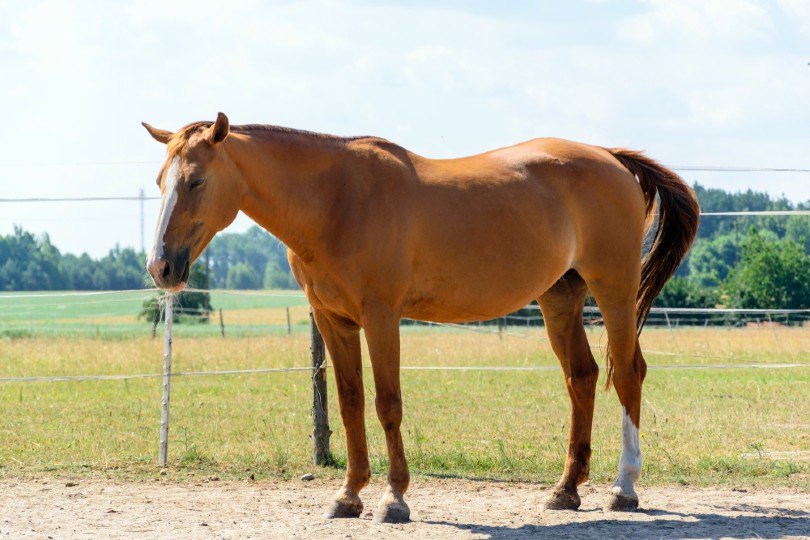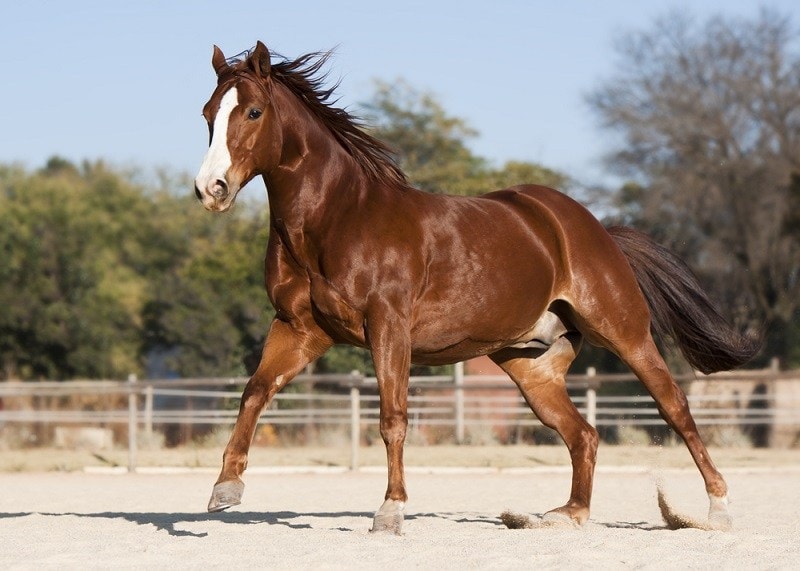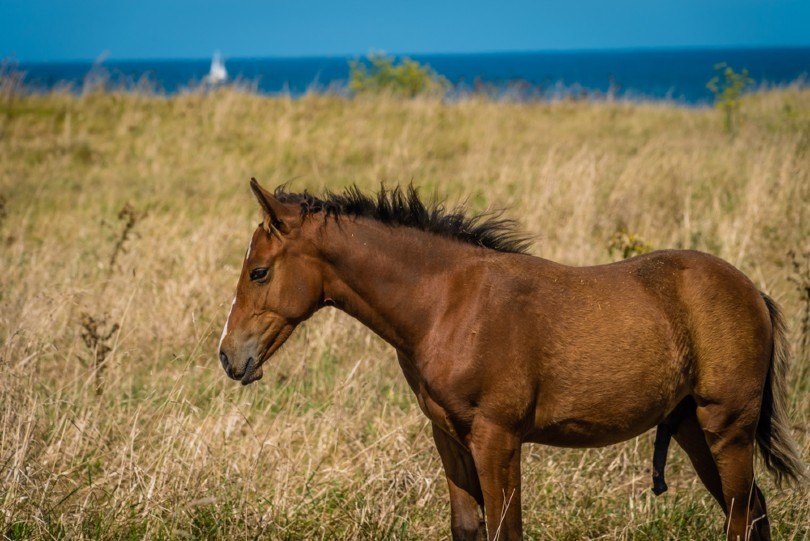

Most people think of horses as rather large creatures, and for the most part, this is true. The average horse stands around five feet tall and weighs 800-1200 pounds. To be considered a horse, the animal must stand at least 57 inches tall, though some equines are barely more than two feet! On the other end of the spectrum, some beastly steeds weigh in at 2200 pounds and stand well over six feet tall. Today, we’re discussing horse heights, and in this article will cover the smallest to the tallest and everything in between.

What Is the Average Height of a Horse?
Though horses span a large range of sizes from rather compact to incredibly massive, most of them fall somewhere closer to the middle. On average, horses are about five feet in height. Many horses are taller and plenty are shorter, but five feet is about average. Of course, horse heights aren’t generally expressed in inches. Rather, they’re usually expressed in hands, and a five-foot-tall horse is 15 hands in height. Don’t worry, we’ll dive into hands and measurements a bit more in-depth shortly.
The problem is, there are just too many different breeds of horse that come in such a range of sizes that it’s really hard to get a true average. Our average height of five feet doesn’t fully account for the tiny ponies and miniature horses that stand considerably shorter, which is why it’s best to look at average horse heights by breed.

Average Height of the Most Popular Horse Breeds
To help you get a better idea of average horse sizes, let’s take a look at some common breeds and a few that are less well known as well, including the shortest and tallest equine breeds.
- Falabella – The Falabella is a miniature horse breed from Argentina and it might be the smallest breed in the world. Falabellas can be as short as 25 inches when fully mature and they never stand taller than 32 inches.
- Shetland Pony – Unlike most horses, Shetlands are actually measured in inches, not hands. On average, they stand about 40 inches tall and never crest the 46-inch mark.
- American Miniature Horse – As the name implies, the American Miniature Horse is a miniaturized version of a full-size horse, which took 400 years of selective breeding to achieve. At the maximum, they can stand 34 inches tall, though most are around 30-32 inches.
- Quarter Horse – Quarter Horses, the most popular breed in the US that also has the largest registry in the world, stand an average height of 14.3 to 16 hands
- Paint – Paint horses stand between 14.2 and 15.2 hands on average, which is 58-62 inches, though specimens with Thoroughbred genes can be quite a bit taller.
- Arabian – According to the breed standard, Arabians can be 14.1-16.1 hands tall, for an average height of 15.1 hands or 61 inches.
- Thoroughbred – Thoroughbreds are lean and strong horses that are primarily used for racing. The average height of a Thoroughbred is 16 hands, which equals 64 inches.
- Belgian – Belgians are some of the biggest horses in the world, weighing an average of 2000 pounds! They’re not quite the tallest breed though, standing 16-17 hands tall on average.
- Clydesdale – Clydesdales are another one of the largest horse breeds that exist. They can stand as tall as 19 hands and weigh up to 2200 pounds, though the average Clydesdale stands about 18 hands or 72 inches tall.
- Shire – If you’re looking for the biggest horse breed on the planet, it’s the Shire. One Shire gelding named Sampson stood an outrageous 21.2 hands in height to earn the title of the tallest horse in history and a Guinness World Record.
Equine Size Chart
| TYPE | HANDS | INCHES |
|
MINIATURE |
6.2 | 26 |
| 6.3 | 27 | |
| 7 | 28 | |
| 7.1 | 29 | |
| 7.2 | 30 | |
| 7.3 | 31 | |
| 8 | 32 | |
| 8.1 | 33 | |
|
SMALL HORSE |
8.2 | 34 |
| 8.3 | 35 | |
| 9 | 36 | |
| 9.1 | 37 | |
| 9.2 | 38 | |
|
SHETLAND |
9.3 | 39 |
| 10 | 40 | |
| 10.1 | 41 | |
| 10.2 | 42 | |
| 10.3 | 43 | |
| 11 | 44 | |
|
PONY |
11.1 | 45 |
| 11.2 | 46 | |
| 11.3 | 47 | |
| 12 | 48 | |
| 12.1 | 49 | |
| 12.2 | 50 | |
| 12.3 | 51 | |
| 13 | 52 | |
| 13.1 | 53 | |
| 13.2 | 54 | |
| 13.3 | 55 | |
|
HORSE |
14 | 56 |
| 14.1 | 57 | |
| 14.2 | 58 | |
| 14.3 | 59 | |
| 15 | 60 | |
| 15.1 | 61 | |
| 15.2 | 62 | |
| 15.3 | 63 | |
| 16 | 64 | |
| 16.1 | 65 | |
| 16.2 | 66 | |
| 16.3 | 67 | |
| 17 | 68 | |
| 17.1 | 69 | |
| 17.2 | 70 | |
| 17.3 | 71 | |
| 18 | 72 | |
| 18.1 | 73 | |
| 18.2 | 74 | |
| 18.3 | 75 |

Why Are Horses Measured in Hands?
Today, measuring anything is quite simple thanks to modern tools like tape measures. But horses were first domesticated many thousands of years in the past, and back then, tape measures didn’t exist. So, people used what was available instead, which was their hands. Measuring a horse with your hands became the standard, and we still use it today.
Granted, back then, there was no unified standard other than the hand, and everyone had different-sized hands, making it a rather imprecise system. Now, a hand has been standardized to four inches. This means you can easily convert hands to inches by simply multiplying the height in hands times four. For example, 15 hands multiplied by four inches comes out to 60 inches.
Sometimes, you might see a decimal behind a hand measurement, such as 15.1. In this case, the .1 represents an inch. So, 15.1 hands equal 61 inches. 15.2 hands is 62 inches. 15.3 hands equate to 63 inches. And since there are just four inches in a hand, after 15.3 hands comes 16 hands, which is equal to 64 inches.
How to Measure a Horse Accurately
We’ve talked a lot about horse’s heights, but how exactly are horses measured? Measuring a person is easy, you just measure from the ground to the top of their head, but measuring a horse is a bit different. Rather than measuring to the top of the head, you’ll be measuring to the top of its withers.
Start by standing your horse on level ground. Using a measuring tape or stick, simply measure from the top of the front shoulder, also known as the withers, to the ground. If you’d like to convert your measurement into hands, you’ll have to find the nearest number down that’s divisible by four and then add the leftover inches in decimal form after you divide.
So, if your horse is 66 inches, find the nearest number down that’s divisible by four, which is 64 in this case. Divide that by four to get 16. You’ve still got two inches leftover that become a decimal of .2 for a conversion of 16.2 hands from 66 inches.
How to Estimate a Young Horse’s Mature Height
If you got a chance to check out the parents of your horse, then you might already have an idea of how large it could become. But if you didn’t get that opportunity, you’re probably wondering what size you can expect your horse to reach. Luckily, there’s a formula you can use to determine the approximate size your horse will be when fully grown.
To do this, your horse will need to be six months old. At this stage, the length of the horse’s lower leg from the hoof to the knee is 93% of the size it will be when fully mature. When your horse reaches maturity, this part of the leg will account for a quarter of your horse’s overall height.
Start with the measurement of your horse’s lower leg. For this example, we will assume it’s 16 inches. You’ll need to divide that measurement by 93, then multiply by 100, and multiply again by four. This will give you the approximate size your horse might grow to, though it’s not an exact science. In our example, 16 divided by 93 is 0.17. Multiply that by 100 to get 17, then multiply by four for an estimated height of 68 inches when fully grown.

What Is the Right Size Horse for You?
As you can tell, horses come in incredible variety. But which size is right for you? It depends on your needs. If you just want to keep a horse for a pet and you want to minimize its care requirements, you might opt for a pony or miniature horse. But if you want to ride your horse, then a pony isn’t going to cut it. For riding, you’ll need to pick a horse that weighs at least seven times what you do to ensure that it’s safe for the horse to carry your weight and all the extra tack.
If you’re on the smaller size, you might choose a horse that’s also a bit smaller; perhaps something around 15 hands. On the other hand, if you’re over six feet tall, you should go for a larger steed that’s standing a good 16-17 hands in height. For heavyweight bruisers, an even bigger horse might be the best bet, such as a giant draft horse like a Belgian or Shire that stands over 17 hands.

Conclusion
Some horses are gargantuan, standing nearly seven feet tall! The average horse is around five feet in height, but ponies and miniature horses come as small as 25 inches! None of these equine breeds is better than any other; they’re just different. Each breed is unique, and with so many different sizes to choose from, there’s a horse out there to fit every rider.
Featured Image Credit: Yurkovski, Shutterstock
An avid outdoorsman, Dean spends much of his time adventuring through the diverse terrain of the southwest United States with his closest companion, his dog, Gohan. He gains experience on a full-time journey of exploration. For Dean, few passions lie closer to his heart than learning. An apt researcher and reader, he loves to investigate interesting topics such as history, economics, relationships, pets, politics, and more.






